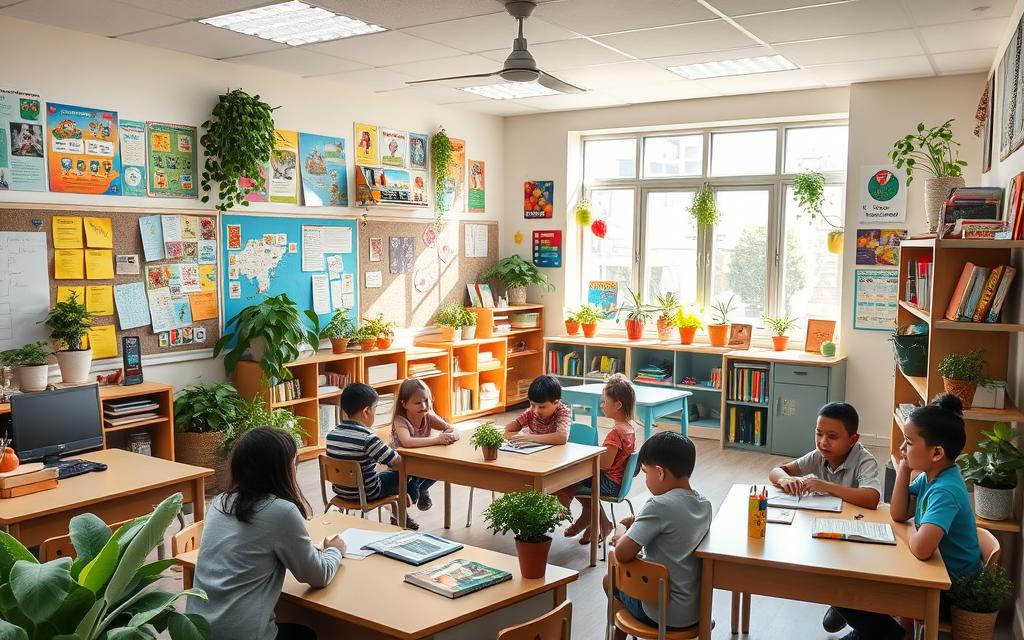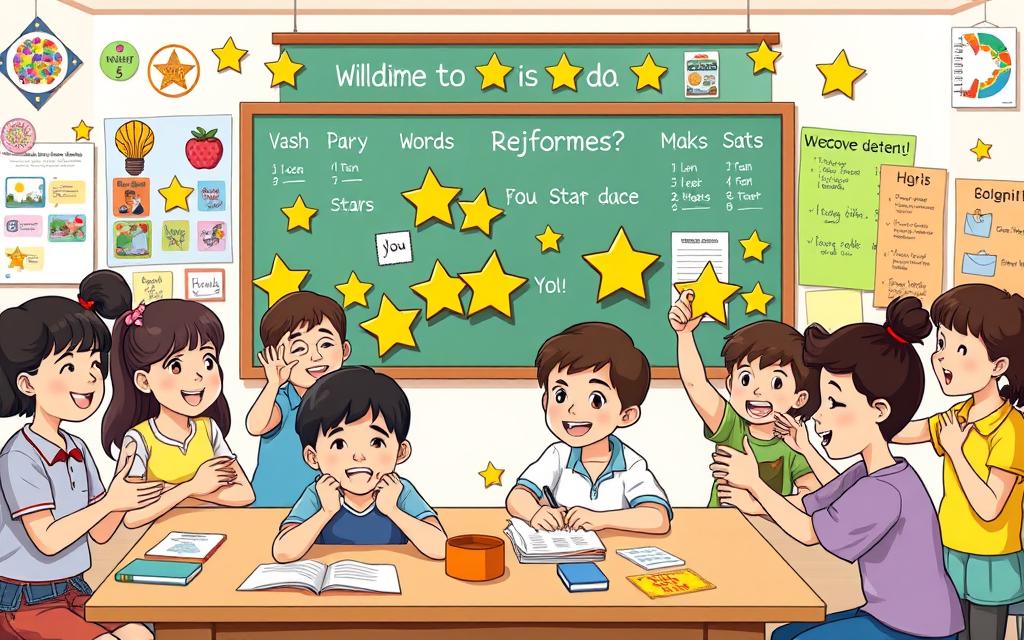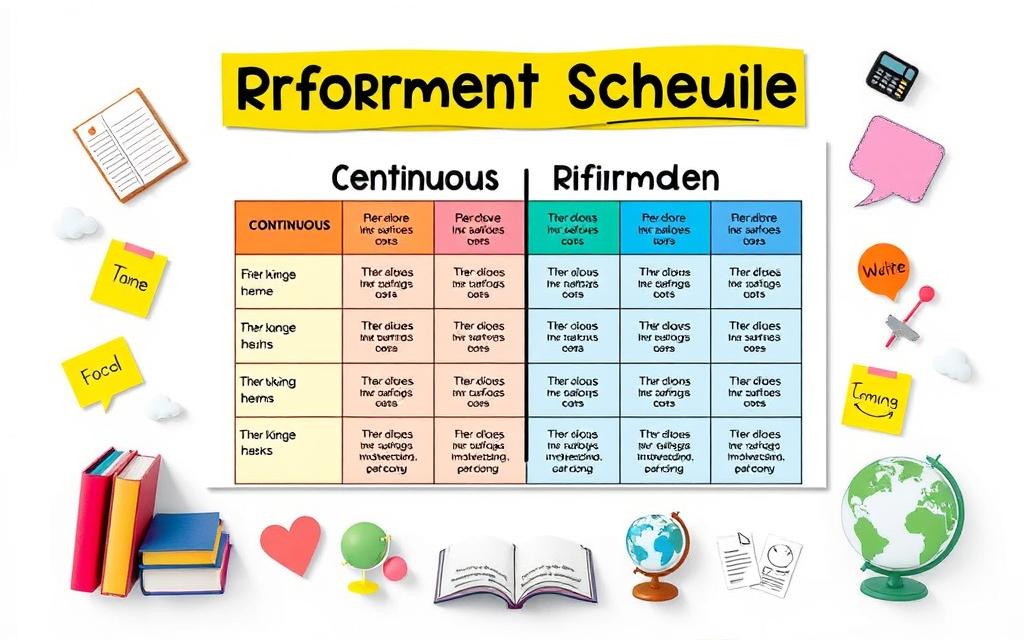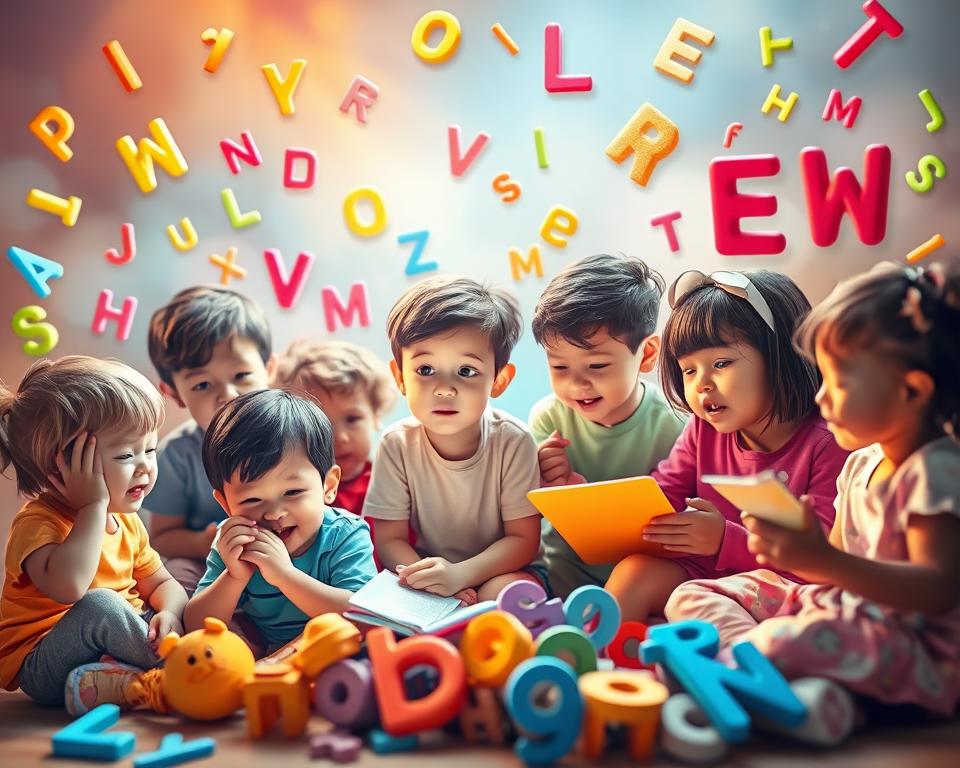Did you know that students who get positive feedback in language lessons are 30% more likely to become fluent? Positive reinforcement is a game-changer in language learning. Positive reinforcement in language learning changes how students learn a new language.
At the core of this method is the idea that motivation and confidence are crucial for learning a language. Teachers use encouragement, praise, and rewards for small achievements. This creates a space where learners feel brave to try new things and grow their skills.
In this article, we’ll explore the science behind positive reinforcement. We’ll see how it works in the classroom and find strategies for all learners. Get ready to see how positive reinforcement can change your language learning journey.
Understand the Psychology of Language Learning Motivation
Motivation is key to learning a new language. Both intrinsic motivation and extrinsic motivation are important. Intrinsic motivation comes from personal interests, while extrinsic motivation comes from things like grades or job needs.
Intrinsic motivation leads to better learning and deeper interest in the language. Extrinsic motivation pushes learners to learn for real-life needs.
Research shows that learner-centered instruction boosts intrinsic motivation. This approach makes learning fun and engaging. It helps students take charge of their language skills, leading to better results.
“Motivation is a goal-directed process emerging from felt needs, sustaining behavior until the satisfaction of a need state occurs.”
Positive feedback, like praise, is vital for intrinsic motivation. When learners feel appreciated for their efforts, they keep learning. This leads to lasting success in language skills.

Knowing how motivation works in language learning is crucial. By understanding both intrinsic and extrinsic factors, we can make learning fun and empowering. This way, learners can reach their goals and succeed in language skills.
The Science Behind Positive Reinforcement in Language Learning
Positive reinforcement is based on behavioural psychology and operant conditioning. It helps make language learning more successful. This method uses rewards to encourage good language use, like praising students for speaking the target language.
Studies have shown that positive reinforcement boosts learners’ motivation and interest. For example, a Minnesota school study found that it made students more engaged in class, based on teacher feedback.
Another study looked at Somali bilingual students. It showed how positive reinforcement can improve their academic and social skills. Building strong relationships and using culturally sensitive teaching methods are key.
Positive reinforcement in language learning relies on reinforcement schedules. These schedules decide when and how often rewards are given. Teachers use these schedules to guide and keep up good language habits, helping students get better over time.
“Positive reinforcement was identified as a powerful tool in enhancing performance in the use of the English language in selected secondary schools in Nakuru town.”
Positive reinforcement’s effects on language learning have been seen in many places. This includes schools in Kenya and classrooms in the U.S. from kindergarten to high school. Knowing how it works helps teachers create better learning environments that keep students motivated and successful.

- Positive reinforcement is grounded in behavioural psychology and operant conditioning.
- Research has shown that positive reinforcement can increase student engagement and motivation in language learning.
- Reinforcement schedules play a crucial role in shaping and maintaining desired language behaviours.
- The impact of positive reinforcement has been observed in diverse educational contexts, from Kenyan secondary schools to American classrooms.
Create an Effective Learning Environment Through Praise
An engaging and supportive learning space is key for student success. Teachers can build a safe place where students feel free to try and learn. This helps students grow in confidence and enjoy learning more.
Using praise well is important for a supportive learning environment. Teachers should point out what students do well and how they’ve improved. This boosts their self-esteem and shows them what to keep doing.
Positive words, like “Great job explaining that grammar concept” or “I can see you’ve been practicing your pronunciation,” help teachers and students connect. This emotional bonding is crucial for a positive classroom atmosphere.
- Identify and acknowledge students’ strengths and improvements
- Provide specific, constructive feedback to guide further learning
- Encourage risk-taking and celebrate mistakes as opportunities to grow
- Foster a collaborative, non-competitive classroom culture
- Demonstrate empathy and understanding towards students’ challenges
By making a caring and praise-filled learning environment, teachers can help students reach their best. They can develop a love for learning languages and set them up for success in the future.

“Positive language in the classroom can aid in diffusing tension and promoting positive conflict resolution.”
Positive Reinforcement in Language Learning: Core Principles and Applications
Learning a new language can be tough, but positive reinforcement helps a lot. Understanding human psychology and what motivates us is key. This knowledge helps in making language learning successful.
Positive reinforcement in language learning is all about praising students’ hard work. It’s about focusing on their progress, not mistakes. Giving specific, sincere feedback is also important. This creates a supportive learning environment. It makes students want to keep learning and growing.
- Praise Efforts, Not Just Outcomes: Acknowledge students’ hard work and progress. This boosts their confidence and encourages them to keep trying.
- Emphasize Progress over Perfection: Focus on the positive steps students take. This motivates them to keep improving.
- Provide Specific, Meaningful Feedback: Give feedback that highlights specific achievements. This makes the praise more genuine and impactful.
Positive reinforcement can be used in many ways to improve language learning. For example, students can practice using the language in real-life situations. This could be ordering food or having casual conversations. Using English-language media, like movies or podcasts, also makes learning more fun and rewarding.
“Positive reinforcement not only helps students learn, but it also fosters a supportive and engaging learning environment that encourages continued practice and growth.” – Dr. Emily Jameson, Language Learning Specialist
By using positive reinforcement, educators can help students overcome language learning challenges. This approach makes learning a new language more enjoyable. It focuses on progress, not perfection.

Effective Feedback Techniques for Language Teachers
Feedback is key for language learners to succeed. Constructive feedback helps them improve and stay motivated. A great method is indirect correction, where teachers ask questions about the correct form. This lets learners fix mistakes on their own without feeling judged.
Praise-based teaching is also very effective. Teachers should focus on the good things students do with language. Giving specific, positive feedback boosts confidence and encourages progress.
- Give detailed feedback on what needs work, not just general comments.
- Use both written and spoken feedback to reach all learners.
- Positive reinforcement, like praising strengths, boosts confidence and motivation.
- Use different rubrics and checklists to help learners understand their work.
- Have learners discuss errors with peers to build confidence and reduce fear.
- Keep feedback sessions safe and respectful to encourage active participation.
By using these constructive feedback methods, teachers can make learning fun and supportive. This helps learners succeed in language for the long term.

Implement Reinforcement Schedules in Language Classes
Positive reinforcement is a key tool in language learning. It greatly affects student motivation and progress. Teachers can choose between continuous or intermittent reinforcement, based on the learning goals and stage.
Continuous reinforcement praises every correct answer. It’s great for teaching new language skills. Intermittent reinforcement only praises some correct answers. It helps keep learned behaviors alive.
Choosing the right reinforcement schedule is important. For new language concepts, use continuous reinforcement to help learners quickly get it. As they get better, switch to intermittent reinforcement. This keeps the target behaviors alive and helps with long-term behaviour modification.
Language teachers can make learning fun and effective by using intermittent reinforcement and continuous reinforcement. This approach boosts language skills and behaviour modification over time.
“Reinforcement is the key to changing behavior, and the schedule of reinforcement can make all the difference in the world.” – B.F. Skinner
Using reinforcement schedules wisely, along with other teaching methods, can lead to amazing language learning results.

Measure the Impact of Positive Reinforcement on Student Progress
It’s key to check how well positive reinforcement works in language learning. Teachers use different ways to see if their methods are helping students. This helps make teaching better and helps students succeed in the long run.
Tracking small steps in progress is important. Teachers watch how students get better at language, feel more confident, and stay motivated. This lets teachers change their methods to fit what students need best. Regular checks show what students are good at and what they need to work on.
Standard tests are also useful. They show how well students can speak and understand language. This helps teachers see if their positive reinforcement is really helping students get better at language.
Surveys about how students feel about learning are also helpful. They tell teachers how positive reinforcement affects students’ feelings and motivation. This gives teachers a better idea of how to help students learn better.
Using a mix of these methods helps teachers make better choices. They can improve their ways of giving positive reinforcement. This ensures students keep getting better at language.

“Positive reinforcement is a powerful tool for enhancing language learning, but its true impact can only be fully realized through regular, data-driven assessment.”
Build Long-term Language Learning Success Through Motivation
Learning a language for the long haul needs motivation. Understanding how positive feedback works helps teachers and learners. This creates a space for lasting interest and growth.
It’s important to set goals you can reach and celebrate each win. Small victories make learning a language feel rewarding. Using the language in real life, like talking to native speakers, makes it even more valuable.
- Focus on the fun and useful sides of learning a language.
- Give feedback right away to help learners improve.
- Use different ways to praise, like words, rewards, or games, to match how each person learns.
- Switch to less frequent rewards to make learning stick longer.
By focusing on sustainable language learning, lifelong learning strategies, and keeping motivation up, we can achieve lasting language skills. This also helps us understand different cultures better.
“The true aim of language learning is not just to acquire a new skill, but to open ourselves up to new perspectives and connect with people from different backgrounds.”
Language learning is a journey, not a finish line. A supportive and positive environment that values progress and success helps learners. They become confident, motivated, and lifelong language lovers.

Positive reinforcement is key in language learning, backed by lots of research and real-world examples. It helps create a supportive environment where students feel motivated and confident. This makes learning a new language more effective and enjoyable.
Positive reinforcement does more than just help in class. It sparks a lifelong love for learning about different cultures and languages. When students are praised for their hard work, they feel more confident and eager to keep learning.
Studies have shown that using positive reinforcement can greatly improve student results. Teachers can use strategies like giving good feedback and making the learning space welcoming. These motivational strategies help students reach their full potential in learning a new language.
Positive Reinforcement in Language Learning
Positive reinforcement is a powerful and widely recognized method for fostering success in language learning. It involves encouraging desired behaviors by rewarding them, creating a positive association with learning tasks, and increasing motivation. Here’s a detailed exploration of how positive reinforcement contributes to language learning success:
1. Encourages Active Participation
When learners know they will be rewarded for participating, they are more likely to engage in activities such as speaking in a new language or answering questions. Rewards, such as praise, stickers, or a simple “well done,” create a safe and encouraging environment for learners to practice without fear of mistakes.
Example:
- A teacher might say, “Great effort on your pronunciation today! I can tell you’ve been practicing,” which motivates the student to keep trying.
2. Builds Confidence
Learning a new language can be intimidating, especially for young learners or beginners. Positive reinforcement boosts self-esteem by recognizing accomplishments, no matter how small. This increased confidence encourages learners to take risks, which is essential for language acquisition.
Example:
- Rewarding a child who attempts to use a full sentence in a new language, even if imperfect, reinforces their courage to try.
3. Develops a Growth Mindset
Positive reinforcement helps learners see mistakes as opportunities to grow rather than failures. This mindset fosters persistence, as students feel supported in their journey and are more likely to view challenges as stepping stones.
Example:
- Saying, “You got closer to the correct verb this time! Keep going!” emphasizes progress and effort.
4. Creates a Joyful Learning Environment
A learning space filled with positivity and encouragement makes language learning enjoyable. When students associate the experience with fun and rewards, they are more likely to engage consistently and develop intrinsic motivation over time.
Example:
- A teacher might use fun games where learners earn points or rewards for using new vocabulary correctly, turning learning into play.
5. Reinforces Specific Language Skills
Positive reinforcement can target particular aspects of language, such as pronunciation, grammar, or vocabulary usage. By recognizing and rewarding specific achievements, learners are more likely to focus on and improve these areas.
Example:
- If a learner correctly conjugates a verb, the teacher might respond with, “Excellent use of the past tense! Keep it up.”
6. Encourages Peer Support
In group settings, positive reinforcement can extend to peer recognition, encouraging collaboration and mutual motivation. When learners see their peers being rewarded, it inspires them to strive for similar achievements.
Example:
- Applauding a group effort, such as a successful dialogue role-play, fosters teamwork and motivation.
7. Builds Long-Term Motivation
Intrinsic motivation often develops from consistent positive reinforcement. Over time, learners internalize the value of their achievements and begin to feel motivated by their progress rather than external rewards.
Example:
- Transitioning from physical rewards (stickers, prizes) to verbal recognition or self-reflection exercises helps learners recognize their growth independently.
Practical Tips for Using Positive Reinforcement
- Be Specific: Instead of general praise like “Good job,” say, “Great pronunciation of the word ‘elephant’!”
- Immediate Feedback: Provide reinforcement right after the desired behavior to strengthen the connection.
- Use Varied Rewards: Mix verbal praise, certificates, small prizes, or privileges to keep learners engaged.
- Recognize Effort Over Perfection: Acknowledge attempts and improvements rather than focusing solely on correct answers.
- Incorporate Gamification: Use point systems, leaderboards, or badges to reward progress in a fun, structured way.
Positive reinforcement is a cornerstone of effective language learning, enhancing motivation, confidence, and engagement. By celebrating progress and creating a supportive environment, teachers and parents can transform language learning into a rewarding and enjoyable experience that yields long-term success.
Would you like examples tailored for a specific age group or language skill?
10 Ways How to Encourage Kids to Learn a New Language
1. Create a Positive & Fun Language Environment
Children learn best when they associate learning with fun and excitement rather than pressure or obligation.
How to Implement:
✔ Turn learning into a game rather than a task.
✔ Use play-based learning (songs, stories, games, and activities).
✔ Encourage a growth mindset—celebrate effort, not just fluency.
✔ Be enthusiastic about the language—your attitude will influence them!
Why It Works:
✔ Reduces language anxiety.
✔ Boosts motivation by making learning enjoyable.
✔ Encourages intrinsic interest in the language.
2. Set Realistic & Achievable Language Goals
Kids feel more encouraged when they see progress and reach small milestones along the way.
How to Implement:
✔ Set short-term goals (e.g., “Learn 5 new words this week”).
✔ Celebrate small wins (stickers, rewards, or special praise).
✔ Use a progress chart to track new vocabulary or phrases learned.
✔ Choose age-appropriate milestones—younger kids can focus on words, while older ones can work on full sentences.
Why It Works:
✔ Creates a sense of accomplishment.
✔ Keeps kids motivated and engaged.
✔ Helps them stay consistent without feeling overwhelmed.
3. Introduce Language Through Play & Games
Children naturally learn through play, making it the perfect tool for language acquisition.
Fun Language Games:
🎲 Simon Says – Teaches action words and listening skills.
🎲 Memory Matching – Strengthens vocabulary retention.
🎲 Charades – Encourages verbal and non-verbal communication.
🎲 Bingo – Reinforces word recognition.
🎲 I Spy – Helps kids learn new words while observing surroundings.
Why It Works:
✔ Turns learning into an interactive experience.
✔ Encourages participation without pressure.
✔ Helps kids practice without realizing they’re learning.
4. Use Songs, Rhymes & Music
Music helps embed language in memory, making it a powerful tool for young learners.
How to Implement:
✔ Play nursery rhymes and songs in the target language.
✔ Encourage kids to sing along to simple, repetitive songs.
✔ Use dance and movement to reinforce meaning (e.g., songs with actions).
✔ Create a playlist of kids’ songs in the target language.
Best Language Learning Songs:
🎵 Frère Jacques (French)
🎵 Head, Shoulders, Knees, and Toes (various languages)
🎵 Los Pollitos Dicen (Spanish)
🎵 If You’re Happy and You Know It (multilingual versions)
Why It Works:
✔ Enhances pronunciation and intonation naturally.
✔ Uses repetition to strengthen memory.
✔ Keeps learning engaging and rhythmic.
5. Watch Cartoons & Movies in the Target Language
Visual storytelling helps kids understand words in context, making learning more immersive.
How to Implement:
✔ Watch age-appropriate cartoons in the target language with subtitles.
✔ Start with familiar shows dubbed in the language (e.g., Peppa Pig, Sesame Street).
✔ Gradually transition to no subtitles as their comprehension improves.
✔ Use language learning platforms like Netflix, YouTube, and Lingokids.
Why It Works:
✔ Exposes kids to native pronunciation.
✔ Reinforces listening comprehension.
✔ Helps with cultural exposure and understanding.
6. Read Books & Storytelling in Multiple Languages
Books introduce new words, sentence structures, and cultural insights in a fun way.
How to Implement:
✔ Choose bilingual books that include side-by-side translations.
✔ Read the same story in both languages on different days.
✔ Ask questions about the story to engage comprehension.
✔ Encourage kids to retell the story in the new language.
Best Multilingual Books for Kids:
📖 Brown Bear, Brown Bear, What Do You See? (multiple languages)
📖 The Very Hungry Caterpillar (various translations)
📖 Little Red Riding Hood (bilingual editions)
Why It Works:
✔ Improves reading comprehension in both languages.
✔ Expands vocabulary naturally.
✔ Encourages active participation in learning.
7. Create a Language Learning Routine
Consistency is key when learning a new language.
How to Implement:
✔ Assign a “language time” each day (e.g., 15 minutes of practice).
✔ Use a weekly language plan (e.g., Monday = songs, Tuesday = games, Wednesday = storytelling).
✔ Speak the target language during certain activities (e.g., bath time, playtime).
✔ Set specific themes (e.g., one week focusing on colors, another on animals).
Why It Works:
✔ Builds habitual exposure.
✔ Prevents kids from forgetting learned words.
✔ Helps reinforce previously learned material.
8. Make Language Learning Social & Interactive
Learning a language is more effective when kids see others using it.
How to Implement:
✔ Arrange playdates with bilingual friends.
✔ Join language immersion groups or cultural events.
✔ Encourage kids to speak with native speakers (e.g., family members).
✔ Travel to places where the language is spoken for real-life practice.
Why It Works:
✔ Creates real-world motivation for learning.
✔ Builds confidence in speaking.
✔ Encourages natural conversation skills.
9. Use Language Apps & Technology
Technology makes learning a fun and interactive experience.
Best Language Learning Apps for Kids:
📱 Duolingo Kids – Gamified language learning.
📱 Lingokids – Play-based lessons with engaging activities.
📱 Gus on the Go – Vocabulary-focused interactive app.
📱 Mondly Kids – Conversational and interactive lessons.
How to Implement:
✔ Let kids explore language apps for 10-15 minutes a day.
✔ Use educational YouTube channels for interactive language learning.
✔ Play language-learning video games that promote vocabulary retention.
Why It Works:
✔ Keeps kids engaged and motivated.
✔ Allows self-paced learning.
✔ Provides instant feedback on pronunciation and grammar.
10. Celebrate Progress & Stay Encouraging
Learning a new language takes time and patience. Kids need positive reinforcement to stay motivated.
How to Encourage Kids:
✔ Praise effort rather than perfection.
✔ Celebrate milestones (first word, first sentence, first conversation).
✔ Offer fun rewards (stickers, small prizes, extra playtime).
✔ Remind them that mistakes are part of learning.
Why It Works:
✔ Builds language confidence.
✔ Encourages consistent learning.
✔ Prevents frustration or language burnout.
Encouraging kids to learn a new language should be a joyful experience rather than a chore. By incorporating play, music, storytelling, technology, and social interactions, children can develop a lifelong love for languages.
Key Takeaways
- Positive reinforcement is a strong motivator for language learners. It keeps them going and makes them feel they’re making progress.
- Praise boosts intrinsic motivation. This leads to better retention of information and a desire to keep learning for life.
- Intrinsically motivated learners often need less review and refresher courses.
- Positive reinforcement helps create a supportive learning environment. It builds learners’ confidence in using the target language.
- Effective positive reinforcement strategies work in many language learning settings. This includes classrooms and language apps.
Source Links
- Why Encouragement and Positive Reinforcement are the Keys to Language Learning Success – https://www.babbel.com/en/magazine/encouragement-language-learning-success
- The Power of Positive Reinforcement – https://praacticalaac.org/strategy/the-power-of-positive-reinforcement/
- PDF – https://files.eric.ed.gov/fulltext/EJ1274645.pdf
- PDF – https://journal.ibrahimy.ac.id/index.php/JOEY/article/download/4379/2097/
- PDF – http://ijhssnet.com/journals/Vol_10_No_1_January_2020/6.pdf
- Using Positive Reinforcement to Increase Student Engagement in The Classroom – https://red.mnstate.edu/cgi/viewcontent.cgi?article=1885&context=thesis
- How to use Positive Language in the Classroom – https://www.pbisrewards.com/blog/positive-language-in-the-classroom/
- Teacher Language: Reinforcing, Reminding, Redirecting, and Envisioning – https://www.responsiveclassroom.org/reinforcing-reminding-and-redirecting/
- 8 Tips for Positive Reinforcement in Child English Learning – https://helendoron.com/english/8-tips-for-using-positive-reinforcement-to-help-your-child-learn-english-as-a-foreign-language/
- Effective Positive Reinforcement in Schools – Veracross – https://www.veracross.com/resources/positive-reinforcement-classroom/
- 6 Strategies for Effective Writing Feedback in ELT | TESOL | International Association – https://www.tesol.org/blog/posts/6-strategies-for-effective-writing-feedback-in-elt/
- Effective Language Teaching Strategies for Educators – https://kwiga.com/blog/how-to-be-a-good-language-teacher
- How Schedules of Reinforcement Work in Psychology – https://www.verywellmind.com/what-is-a-schedule-of-reinforcement-2794864
- 5 Key Factors to Make Positive Reinforcement Work – https://www.n2y.com/blog/make-positive-reinforcement-work/
- PDF – https://ojs.jdss.org.pk/journal/article/download/801/735/1046
- The Effect of Teachers’ Use of Reinforcement on Learners’ Performance in English Language – https://www.academia.edu/79626746/The_Effect_of_Teachers_Use_of_Reinforcement_on_Learners_Performance_in_English_Language
- Investigating the Effectiveness of the Positive Reinforcement Components of Tootling – https://cornerstone.lib.mnsu.edu/cgi/viewcontent.cgi?article=2192&context=etds
- The Magic Of Positive Reinforcement: Shaping Behaviors And Building Confidence – https://kidsontheyard.com/articles/education/teaching-content/positive-reinforcement/
- Boosting Student Motivation in World Language Classes This Year – https://www.edutopia.org/article/boosting-student-motivation-world-language-classes-year/
- PDF – https://journals.eduped.org/index.php/ijcse/article/download/945/612/4268
- PDF – https://www.atlantis-press.com/article/125957989.pdf
- IMPACT OF POSITIVE & NEGATIVE REINFORCEMENT ON LANGUAGE LEARNING.docx – https://www.academia.edu/32166197/IMPACT_OF_POSITIVE_and_NEGATIVE_REINFORCEMENT_ON_LANGUAGE_LEARNING_docx



